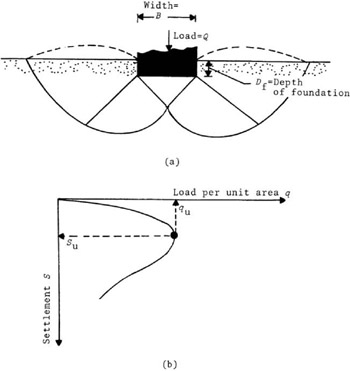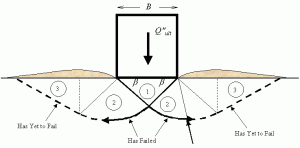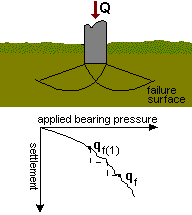General Shear Failure
When the sudden failure in the dense sand or stiff cohesive soil supporting the foundation takes place and the failure surface extends to the ground surface, the failure will be the general shear failure.
If a strip foundation resting on the surface of dense sand or stiff cohesive soil. Now if a load is gradually applied to the foundation, settlement will increase. At a certain point when the load per unit area equals to the ultimate bearing capacity of the foundation, a sudden failure in the soil supporting the foundation will take place. The failure surface in the soil will extend to the ground surface. This type of failure is called general shear failure.

Local Shear Failure
When the failure in the sand or clayey soil of medium supporting the foundation takes place and the failure surface in the soil will gradually extend outward from the foundation, the failure is called as local shear failure.
When the load per unit area on the foundation equals first failure load, movement of the foundation accompanied by sudden jerks. A considerable movement of the foundation is then required for the failure surface to extend to the ground surface as shown by the broken lines in the figure. The load per unit area at which this happens is the ultimate bearing capacity. Beyond that point an increase in load will cause large increase in foundation settlement.

The load per unit area of the foundation when the moment of foundation will accompanied by sudden jerks is known as first failure load.

Punching Shear Failure
If the soil is so loose that it cannot sustain the shearing forces developed on the failure surface, the soil underneath will collapse, causing the shear zone to progress downward, more or less vertically.
If the foundation is supported by fairly loose soil, the failure surface will not extend to the ground surface. Beyond the ultimate failure load, the load settlement plot will be steep and practically linear. This type of failure in soil is called punching shear failure.

Leave a Reply